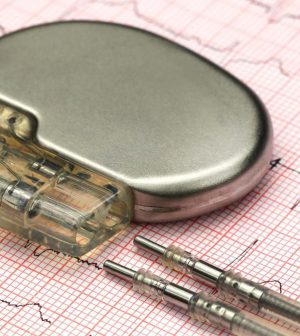- Navigating Your Midlife Crisis: Embracing New Possibilities
- City Raccoons Showing Signs of Domestication
- Mapping the Exposome: Science Broadens Focus to Environmental Disease Triggers
- One Week Less on Social Media Linked to Better Mental Health
- Your Brain Changes in Stages as You Age, Study Finds
- Some Suicide Victims Show No Typical Warning Signs, Study Finds
- ByHeart Formula Faces Lawsuits After Babies Sickened With Botulism
- Switch to Vegan Diet Could Cut Your Greenhouse Gas Emissions in Half
- Regular Bedtime Does Wonders for Blood Pressure
- Dining Alone Could Mean Worse Nutrition for Seniors
What is a Heart Pacemaker?

Millions of people worldwide live with a pacemaker that regulates their heartbeat, but exactly what are these devices and how do they work?
Pacemakers can save the lives of heart patients by preventing conditions like bradycardia, or a slow heart rate. Since the invention of the pacemaker in 1960, improvements to their original technology have been underway. Researchers are developing tech-forward devices like leadless pacemakers, pacemakers so small no surgery is needed, and even pacemakers that can dissolve once they are no longer needed.
What is a pacemaker?
A pacemaker is a small device that is implanted underneath the skin to help regulate your heartbeat with electrical impulses. It consists of a small, battery-powered generator and one or more leads that are placed directly in the heart.
“Pacemakers are designed just to keep the heart from going too slow…that’s the simplest type of cardiac implantable electronic device,” cardiologist Dr. Bruce Wilkoff explained in a Cleveland Clinic interview. The generator sends electrical impulses to the heart, keeping it beating at a regular pace. Pacemaker implantation can be permanent or temporary.
Types of pacemakers
The type of pacemaker used will depend on a patient’s heart problem, according to the Cleveland Clinic. Pacemakers contain one to three leads that connect to ventricles or atria, which are the chambers of the heart. Pacemaker types include:
- Single-chamber pacemakers: These devices have one lead connected to one chamber of the heart. They treat conditions like bradycardia.
- Dual-chamber pacemakers: These devices have two leads, one connected to the right atrium and one connected to the right ventricle. They treat conditions like atrioventricular blocks (partial or complete interruption of electrical impulses from the atria to the ventricles).
- Biventricular pacemakers: These devices have three leads, one connected to the right atrium, and the other two to the lower chambers. They are used to treat more advanced conditions like heart failure.
How does a pacemaker work?
A pacemaker works by sending electrical impulses to the heart to maintain a regular heartbeat. The generator is connected to the heart via leads, which detect the heart’s natural electrical activity. If the heart beats too slowly, too quickly or irregularly, the pacemaker sends electrical impulses to the heart to help it beat at a regular, healthy pace.
What happens during pacemaker surgery?
The type of surgery will depend on the type of pacemaker that will be implanted, according to the Cleveland Clinic. Traditionally, pacemaker surgery is a minimally invasive procedure that is usually performed under local anesthesia, so you are awake for the surgery. A small incision is made in the chest and the generator is implanted under the skin, then connected to the heart via leads. The leads are passed through a vein and positioned in the heart. The procedure typically takes about an hour and patients can go home the same day.
However, with improved technology, pacemaker implantation does not always require surgery. Dr. Larry Chinitz, director of the Heart Rhythm Center at NYU Langone Health, was the first to implant a new type of pacemaker that “can do everything a conventional pacemaker can do, only with far fewer complications,” he explained recently. Smaller than a vitamin, can be implanted into the heart with a catheter threaded through a large vein in the groin. No surgical incisions are made and no activity restrictions are required right after implantation.
Defibrillator vs. pacemaker: What’s the difference?
A defibrillator and a pacemaker are two different, but similar, devices, according to the Cleveland Clinic. Generally, pacemakers treat bradycardia, or a slow heartbeat, and implantable cardiac defibrillators (ICDs) can treat tachycardia, or fast heartbeats.
Unlike pacemakers, ICDs can also treat a life-threatening heart condition known as ventricular fibrillation, a type of arrhythmia in which the lower heart chambers rapidly contract in an uncoordinated manner, the Cleveland Clinic said. When a ventricular fibrillation is detected, ICDs deliver a strong electric shock to the heart to restore a normal heartbeat. ICDs can be larger than pacemakers and are implanted beneath the collarbone.
Things you can’t do with a pacemaker
If you have a pacemaker, there are certain things that should be avoided to prevent damage to the device, according to the Mayo Clinic. Some of these include:
- Avoid strong magnets: Strong magnets can cause a pacemaker to deliver inappropriate shocks or completely stop the pacemaker from working.
- Avoid certain activities: Contact sports like football and rugby, and activities that involve heavy lifting like weightlifting, should be avoided to prevent device damage.
- Avoid certain equipment: Things like cellphones, metal detectors, MRIs, CT scans, radiation treatment for cancer, electric blankets and heating pads can also interfere with pacemaker function and should be avoided.
Because each patient is unique, talk with your doctor about what activities or types of equipment to avoid with your pacemaker.
Source: HealthDay
Copyright © 2025 HealthDay. All rights reserved.










